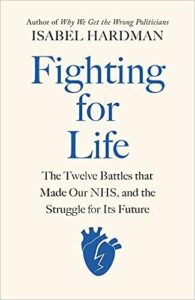Arpan K. Banerjee
Solihull, UK

The United Kingdom’s National Health Service (NHS) was born on July 5, 1948, and on the seventy-fifth anniversary of its existence, British journalist and broadcaster Isabel Hardman has produced a book using military analogies to focus on the many political battles and political contests that have shaped its current form.
The idea of a health service can be traced back to William Beveridge, an economist who, at the turn of the twentieth century, visited Germany and studied the Bismarck model on social insurance. In 1942, he produced a report arguing for a better welfare state and health service to meet the needs of the public from cradle to grave.
The service would be funded centrally by national insurance and taxation. At first, the idea of a free health service was not greeted with enthusiasm by the British Medical Association, and much negotiation and cajoling were required by such individuals as Aneurin Bevan, the Health Minister, who championed the creation of the NHS and is said to have stuffed the mouth of the doctors with gold to persuade them to accept this new state of affairs.
In its early days, this new service was greeted by the public with enthusiasm. With time, however, demand increased, and a large, previously unmet need for care and medical advances meant that a major problem was the growing cost of providing this free care. At the time of the inception of the health service, many of the hospital facilities were primitive, old, and had often been built in the Victorian era. Constant resources were required to modernize hospitals and keep up to date with medical advances. This constant requirement for more money with little accountability has been a source of conflict, with the NHS often a political football.
Hardman describes initial staffing problems and the reliance on overseas qualified nurses and doctors, which continue to this day. The pioneering work of the NHS in many areas is celebrated. From heart transplants to cutting edge imaging technology and oncology, in the best hospitals, care provided is often second to none.
However, over the years, reorganization after reorganization wearied staff. More robust management of hospitals was brought in following the Griffiths report, commissioned by Margaret Thatcher’s administration in 1983. The late 1980s saw the introduction of internal markets, general practice fundholding, purchaser/provider split, and hospitals becoming trusts with chief executives and management boards. Many of these reforms were not welcomed by doctors. With management, a new bullying style of coercion and toeing the line began to permeate hospital culture.
Major scandals around poor hospital care in the 1990s drove focus away from merely balancing the books to safe practices and care at the core. The range of services provided by the NHS is vast, and with medical innovation, newer therapies are constantly being introduced. Unfortunately, medicine is a victim of its own success, and improved treatments for many conditions such as heart disease and various cancers mean we are living longer only to be afflicted by conditions such as Alzheimer’s disease. There is a brief chapter on how the NHS dealt with COVID and on the profligate spending of money, lack of accountability, and waste of resources that occurred.
Finally, the book concludes with some thoughts about the future of this institution, which in Britain is defended with religious zeal even though today other countries have health care systems with better patient outcomes and no waiting lists.
The book provides a good introduction to the NHS. It is a well written and balanced chronicle of all the changes, reorganizations, and political shenanigans that have occurred throughout the last 75 years. Many who have worked in the NHS and lived through these reorganizations will have a sense of deja vu upon reading this book.
Fighting for Life: The Twelve Battles that Made Our NHS and the Struggle for Its Future
Isabel Hardman
Penguin Viking, 2023
ISBN 9780241504345
ARPAN K. BANERJEE, MBBS (LOND), FRCP, FRCR, FBIR, qualified in medicine at St. Thomas’s Hospital Medical School, London. He was a consultant radiologist in Birmingham from 1995–2019. He served on the scientific committee of the Royal College of Radiologists 2012–2016. He was Chairman of the British Society for the History of Radiology from 2012–2017. He is Treasurer of ISHRAD and adviser to Radiopaedia. He is the author/co-author of numerous papers and articles on a variety of clinical medical, radiological, and medical historical topics and seven books including Classic Papers in Modern Diagnostic Radiology (2005) and The History of Radiology (OUP 2013).

Leave a Reply